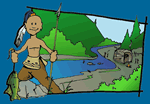


Geography and Landforms:
Washington is bordered by Canada in the north and Oregon on the south. On the east, Washington is bordered by Idaho and on the west; it is bordered by the Pacific Ocean.
|
 History:
In the mid-1700s, two groups of explorers and settlers converged on the area that is now Washington. First, Russian fur traders had crossed the Bering Strait and began to settle in the area we now know as Alaska. Meanwhile, Spanish explorers led by Bruno Heceta came north from California. They landed near present-day Point Grenville in 1775 and claimed the Washington region for Spain. Spain continued to explore Washington in an attempt to prevent Russian traders from claiming land further south than Alaska.
|
 Economy:
Water is central to the economy of Washington, and although the state borders the Pacific Ocean, it is the Columbia River that has the greatest impact. From its earliest use by Native Americans as a travel route and a source of salmon in their diet to the more modern use of hydroelectric power generated by the Grand Coulee Dam, the Columbia River is crucial.
|
 First Inhabitants:
Between 12,000 and 16,000 years ago, a group of nomadic hunters crossed the frozen Bering Strait from Siberia into present-day Alaska and eventually moved further south into the Pacific Northwest. Although distinct communities developed over time, all of these native groups were dependent upon the land and the water for their livelihood. Most of their lives revolved around fishing, the smoking and drying of fish, and moving across the land in search of fish. They lived in waterside villages of cedar plant houses. Another distinctive feature of these groups was their building of totem poles, which tell the stories of families, clans and individuals.
|
Books Related To WashingtonAll-American Girl - Meg Cabot Annie's War - Jacqueline Sullivan Brendan Buckley's Universe and Everything in It - Sundee Frazier E is for Evergreen: A Washington State Alphabet - Roland Smith The Ghost's Grave - Peg Kehret The Ghost, the White House, and Me - Judith St. George Grape Thief - Kristine Franklin Gym Candy - Carl Deuker N is for Our Nation's Capital - Roland Smith The Rhyming Season - Edward Averett Seaglass Summer - Anjali Banerjee The Stranger Next Door - Peg Kehret The Trouble with May Amelia - Jennifer Holm Yang the Third and Her Impossible Family - Lensey Namioka |
Famous Citizens:
|
| Capital: | Olympia |
| Entered Union: | November 11, 1889 |
| Population: | 7,061,530 |
| Area | 71,300 |
| Bird | Willow Goldfinch |
| Flower | Pink Rhododendron |
| Nickname: | Evergreen State |
| Governor | Jay Inslee |
Places to Visit in Washington: (Click the links to learn more.)
|



